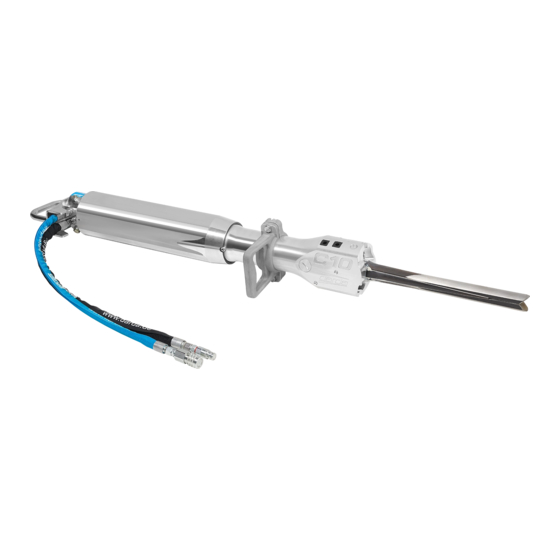
Table of Contents
Advertisement
Advertisement
Chapters
Table of Contents

Summarization of Contents
1 Introduction (Information Manual)
1.2 Product Identification / Product Information
Provides details on Darda splitter types, model identification, and naming conventions.
1.5 Responsibility of the Operator
Outlines the operator's duties regarding safety, training, and device operation.
1.6 Intended Use
Specifies the approved applications for the Darda splitters, excluding unauthorized uses.
1.9 Guarantee and Liability
Details the terms and conditions for warranty claims and manufacturer liability.
2 Device Data Sheet
Name Plate Information
Instructions for recording device-specific data from the name plate.
3 Technical Data (Information Manual)
3.1 Splitters
Provides specifications for different Darda splitter models including dimensions and forces.
3.2 Hydraulic oil
Specifies recommended hydraulic oil types for normal and cold conditions.
4 Servicing, Maintenance, and Repair
Personnel Qualifications for Servicing
Emphasizes that only authorized and trained personnel can perform maintenance.
5 Information for Disposal
5.2 Disposal of Old Oil
Provides guidelines for environmentally friendly disposal of used hydraulic oil.
Appendix A: List of Signatures
Signature Procedure
Outlines the process for staff to confirm training and understanding of the manual.
1 Introduction (Operating Manual)
1.4 Definition of Terms
Defines key terms used throughout the operating manual for clarity.
1.5 Symbols in this Manual
Explains various symbols for warnings, instructions, and general information.
1.6 Responsibilities of the Personnel
Details the duties and responsibilities of personnel working with the device.
1.9 Personal Protective Gear
Recommends specific personal protective equipment for safe operation.
2 Safety Instructions
2.1 Intended Use
Specifies the correct applications for the hydraulic stone and concrete splitter.
2.2 Hazards Overview
Covers dangers from hot surfaces, surroundings, lighting, pressurized parts, and weather.
2.8 Safety Instructions for Commissioning
Provides crucial safety steps before starting up the device.
2.9 Personal Protective Gear
Details required PPE such as safety shoes, masks, gloves, and hard hats.
3 Device Description
Section of a Splitter
Illustrates and labels the key components of the splitter.
4 Work Preparation
4.1 Drilling Boreholes
Provides instructions for correctly drilling boreholes to avoid splitter damage.
4.2 Connection to Hydraulic Hoses
Details the procedure for connecting hydraulic hoses to the splitter and aggregate.
4.3 Lubrication
Explains the importance and procedure for lubricating the splitting head and pressure pieces.
5 Commissioning, Operation, and Shut-down
5.1 Commissioning and Operation
Covers the initial setup and general operation of the splitter device.
5.3 Safety-conscious Work
Emphasizes safe practices during splitting processes, including danger zones.
5.5 Shut-down Procedure
Provides instructions on how to safely shut down the hydraulic aggregate and device.
6 Replacing Splitting Heads
6.1 Splitter Type C4S
Details the expansion of the splitting wedge and/or pressure pieces for the C4S model.
6.2 Splitter Type C9, C10S, C12
Describes exchanging pressure pieces for C9, C10S, and C12 splitter types.
6.3 Maintenance Every 6 Years
Specifies the mandatory replacement of hydraulic connections every six years.
7 Troubleshooting
Error Diagnosis and Solutions
Provides a flowchart for diagnosing and resolving common operational errors.
8 Technical Data (Operating Manual)
8.1 Splitters
Lists technical specifications for various splitter models, including dimensions and forces.
8.2 Hydraulic oil
Recommends hydraulic oil types for different operating conditions.
9 Disposal
9.1 Disposal of Old Oil
Provides guidelines for environmentally friendly disposal of used hydraulic oil.


Need help?
Do you have a question about the C9 and is the answer not in the manual?
Questions and answers